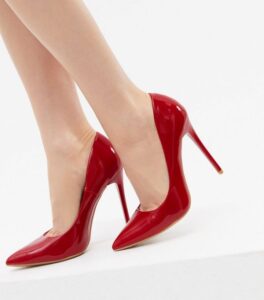| Imagine you’re at a trailhead in the wilderness. Sunrise is lightening the eastern sky, birds are singing their dawn song in the tops of the firs, and the creek beside your trail is burbling happily, full of fresh snowmelt, beckoning you upward. You’re excited to climb to the top of the mountain on the horizon, with the last of the night’s stars fading away behind it. You’ve wanted to climb this mountain for years, and today is the day. You take one last drink of water, shoulder your pack, strap on your hiking poles, and embrace the journey ahead. But then. A voice. It belongs to a young man emerging from the trees. He wears an official uniform and a badge, and he tells you to stop. “Hold up,” he says. “I’m going to give you some of these before you go.” He gestures to a table laden with a strange assortment of objects: rocks in ten-pound bags, pairs of shiny red stilettos, rolls of Cling Wrap, and heavy mittens. He tells you to remove your sturdy trail shoes and replace them with the stilettos, puts two bags of rocks in your backpack, and wraps your head in Cling Wrap in which he’s poked tiny holes for your nose and your mouth. You object, although it’s difficult through the plastic wrapped around your head. He says, “Sorry, ma’am. This is how it is. I don’t make the rules. Oh. I almost forgot. You have to give me half your food.” This seems strange to you. You wonder who’s making these rules, but you give the young man most of your lunch and start up the trail. You’re beginning to wonder if you’ll make it up that mountain. Thoughts create feelings which lead to actions that accumulate as results. Period. That’s what I learned in Wayfinder coach training, and it’s what I’ve taught clients myself. The idea is that once we can catch a thought causing suffering, we can do the work to change the thought. Because, thankfully, thoughts, unlike feelings, are changeable. (Changing an action without changing the thought(s) motivating the action is white-knuckling ourselves into a desired state. This “change through brute force” takes lots of will power, a finite resource.) This black and white, clear cut, linear formulation is the foundation of Cognitive Behavior Therapy (CBT), and it’s been helpful for many. Well. Turns out it’s not true, that feelings are always, 100%, no exceptions, caused by thoughts. Researchers are finding that what eases suffering isn’t changing the thought, but getting distance from it. Learning to detach from a thought causing suffering is one of the pillars of Acceptance and Commitment Therapy (ACT). I now have a broader understanding and therefore a more nuanced perspective on thoughts, feelings, and actions. Thoughtwork is great for thoughts causing suffering. We suffer when we take life’s inevitable pain personally. Thoughtwork used on pain, not suffering, is ineffective and potentially harmful. That said, “unhelpful thoughts create unhelpful feelings that lead to unhelpful actions” is true often enough that it’s worth having some basic thoughtwork tools in your toolbox to ease your suffering. I’ve been playing around with a new one, and want to share it with you. It’s called “Cruel, Sadistic Operating Instructions.” Cruel, Sadistic Operating Instructions I found this one in Carolyn Elliott’s book Existential Kink. (The book has a lot of wacky stuff IMO, but this tool is priceless.) She calls it “How to Beat Yourself Up (the Fun Way).” In Carolyn’s words: “Make your cruel, sadistic ‘operating instructions’ radically explicit.” Here’s how it goes. Dig deep and see if you can uncover the real rules you live by—your cruel, sadistic operating instructions. We find our cruel, sadistic operating instructions when we investigate where we’re suffering. You know what suffering feels like. It feels weighty, stuck, trapped, caged, stagnant, frustrating. Anger that never goes away. Despair that persists. Attempts to control the uncontrollable. Pain, by contrast, moves through us. Pain ebbs and flows. Pain is alive. Look where you feel deadness, and you will find your suffering. Here are some of my cruel, sadistic operating instructions: I must never, ever, ever expand and grow bigger than my childhood roles and identity. I must never, ever, ever, create something original—art, writing, a coaching process, a business—because it might be flawed or ugly and therefore unworthy of existence. The only thoughts that matter are the ones others think or have thought. I must always listen and never speak. I must never, ever, ever decide anything for myself. I must never, ever, ever feel exuberant happiness. I must never, ever, ever do anything I might not get perfect the first time. No mistakes, ever. And so on. Now, of course these aren’t true. They’re ridiculous—statements I would never, ever, ever say to my kids or to anyone else. I have managed to expand, create, think for myself, speak up, feel happy, and make decisions. But doing those things has been harder than they needed to be, because of my buried operating instructions. Articulating my actual cruel, sadistic operating instructions helps me see how they’re still controlling me. I’ve been white-knuckling myself past my operating instructions, feeling anxious and guilty when I break them. They’re buried deep. Like vampires, exposing these rules to the light takes away their power. Uninstalling the operating instructions that no longer serve me is a skill. And that’s where thoughtwork comes in. So, what’s going on with you, dear mountain climber? Well, you’re doing your best to get up that trail with all those impediments. After all, you think, this is how he said it needed to be. I don’t understand, but I don’t have a choice. This must be how everyone does it. Maybe there’s something wrong with me, that this is so hard. You walk and you walk and you walk, grinding out step after step in those god-awful shoes, sweat pooling under the Cling Wrap, trying to see through the layers of plastic film, carrying that heavy, heavy backpack. Until you just can’t anymore. You teeter your way to the creek bank, heels catching on rocks, ankles twisting, and slide down onto the grass. You shrug off your backpack, kick off those ridiculous shoes, rip the Cling Wrap from your head, and put your feet in the water. Cold water flows over your blistered feet, fir-scented breezes cool your sweaty head, your shoulders relax and soften. A Dipper flies downstream. You’re tapped out. You’ve hit a wall. You know you can’t go any further, and you so badly wanted to get to the mountain top. You sit, trying to accept your disappointment. Then you notice that the Dipper is in the creek in front of you, watching you. She’s been there for some time, perched on top of a log in the water on the other side of the creek, singing and dipping as Dippers do. The log is hollow, and inside the log is a box. You wade toward the log. The Dipper watches your steady progress, bopping up and down encouragingly. You reach the log and pull out the box. Behind the box, deep in the hollow log, is a pair of sturdy trail shoes, your size, in the color you always wanted but REI was always sold out of. Oh, hell no, you think. I am not wearing those ridiculous stilettos one more goddamn minute. You carry the shoes and the box back across the creek. Sitting there with your feet in the water, the fir-scented breeze playing with your hair, the sound of the creek in your ears, you open the box. Inside is the food you left with the young man at the trailhead—your turkey sandwich, your bag of Fritos, and your oatmeal cookie. You’re beginning to believe you can get to the top of the mountain after all. Why would I keep carrying this stuff?, you think. You pull the bags of rocks out of your backpack and empty them into the creek. You stuff the empty bags, the wad of sweaty Cling Wrap, and your lunch into the backpack, dry your feet, and put on your beautiful new shoes. They feel so good. You return to the trail and resume your journey toward the mountain that is your goal: snow-capped, sturdy, shining in the morning sun. You’re strong. You’re brave. And you’re really looking forward to getting to the top of that mountain. Those stilettos? They’re swinging jauntily off your backpack by their sparkly straps. You’re not sure yet what you’ll do with them, but you know it’ll be something good. PS. If you’d like to share your Cruel, Sadistic Operating Instructions, hit reply. Confidentiality guaranteed. You can also tell me what you’ll do with those damn stilettos. I’d love to know! PPS. If you’d like to explore your operating instructions together, I offer a no-cost, no-obligation Clarity Call. PPPS. Thoughtwork is an integral component of Being Embodied, my intensive coaching program. I’ve offered Being Embodied in a private format for two years. I’m excited to announce that I’m offering it as a group program for the first time, starting on April 19th. More information will be coming next week! My weekly-ish newsletter is where I share my latest writing, offerings, and news. You can subscribe here, and thank you! Photo credit: Amazon. |
Tag Archives: thoughtwork
What’s your plan for Election Night?

Do you have a plan for Election Night?
There’s been a lot of talk about having a plan to vote. But do you have a plan for AFTER the vote?
My husband asked me this morning how I wanted to handle Tuesday night. My thoughts went immediately to alcohol. Tequila if things don’t look so good, and champagne if things go well. Maybe both.
But that’s not really functional, is it? It’s human to buffer our emotions occasionally, of course. It’s best not to make a habit of it.
It turns out that what worries me about Tuesday night is that I won’t be able to handle my feelings if Trump wins. I suspect if you dig down under your thoughts, you’ll find the same thing. Worrying about and anticipating my fear ahead of time just means that I’m feeling fearful of my fear ahead of time, before the event I’m anticipating has even happened. It’s a little nuts, and completely understandable if you have a human brain, like I do.
I know it’s my thoughts causing my feelings.
But what do I do about my thoughts – thoughts that seem so reasonable, given the state of our nation and my beliefs about Donald Trump’s four years in the White House?
This is what I was mulling over as I listened to Kara Loewentheil’s Unf*ck Your Brain podcast, devoted this week to Election Emotions.
Kara confirmed for me that what I was actually afraid of was feeling overwhelmed by aching despair, hopelessness, and anger if Trump wins. You can read here and listen here.
What will actually help me these next few days, before and after November 3rd, is to have a plan. Kara suggests four components:
1. Decide, intentionally, what thoughts you want to think. Choose your thoughts and feelings on purpose.
2. Schedule twenty to sixty minutes each day, blocking out news and social media, to accomplish one or two important tasks. Commit to what’s important to you, and take action.
3. Give yourself at least ten minutes of pleasure each day.
4. Write one sentence of gratitude every night.
After you read or listen, follow the prompts to download Kara’s “Survive This Election” pdf. You’ll be glad you did, I think.
I can’t stress highly enough how much I want you to listen to this episode. It will be 23 minutes well-spent, I promise you.
I’m taking Kara’s advice one step further. In the spirit of NaNoWriMo (National Novel Writing Month), I’m declaring November PeArMaMo, my own Personal Art-Making Month. I commit to making some art each day and posting it on Instagram. I also plan to write daily, focusing on the sequel to Lost and Found, my Camino novel. I may post snippets of that, as well. PeArMaMo doesn’t please the ear like NaNoWriMo, but it will have to do. Perfectionism sucks the life out of life.
Our brains hate uncertainty. We are currently swimming in uncertainty. What a perfect time to flex our grown-up muscles and take some control of our minds and our feelings, right? {Insert smiley face here.}
Make a plan. Choose your thoughts on purpose, and your feelings will follow. Commit to making the world a better place, no matter what happens on November 3rd.
The world is my field of practice. Unfortunately.

(Salty language warning)
Friends, my life is really hard right now. People are doing things that are bugging the living crap out of me.
I’m not talking about the political landscape or COVID or global climate change.
What’s really bugging me right now is the people across the street who have left their porch lights on two nights in a row and they’re really bright, shining into our bedroom, and the assholes aren’t even home. They’re never home. They won’t be home for weeks.
And it’s the jerks pitching their tents where they’re not supposed to at my favorite mountain lake.
And it’s the shitheads across the lake making so damn much noise. I come up here for silence and solitude. And then one dude decides to skin off his clothes and go for a swim buck naked, and so of course he has to holler to the others that his penis has shrunk (not the words he actually used.). Because the water is cold. In October. At 6,000 feet in the mountains. And these aren’t kids. These are men and women in their 60s. Oh my effing god.
There I sit, feet in the lakeside gravel, maroon snow-striped mountain looming over me, fuming, aware that when I get home those fucking porch lights will still be on. And they were. They still are.
I can’t seem to help it. I have a sensitive nervous system. The lights and the noise don’t deeply piss off most people like they do me, if my spouse is any indication.
So, what’s a girl to do? The world isn’t showing signs of accommodating my sensitivity any time soon.
I, swear to god, asked myself what the Buddha would do, and then I used the tools I have at my disposal. Two tools in particular have been helpful: thoughts cause feelings, and the Karpman drama triangle.
I know that it’s my thoughts causing me to suffer. (See this post for more.) I was already changing my actions by not yelling at the (probably Californians) to shut the fuck up, not unscrewing those damn lightbulbs (jury’s still out on that one), and not telling the fisherman his goddamn tent was where it wasn’t supposed to be (I’m guessing he knew). So I needed to look at my thoughts to find relief. When I did, I heard myself say things like “I hate my sensitivity.” “I wish I could be okay with this shit, like other people.” “People should be more considerate.” “People shouldn’t fuck with my peace.”
All these thoughts are victim thoughts. My frustration and outward focus, my helplessness and lack of options, all indicate that I was stuck in Karpman’s drama triangle, playing the victim role extremely well. I’m not sure how to get into the creator’s place of empowerment yet, and just noticing where I was stuck helped so much. Because it’s not going to get any easier. And giving external people and circumstances power isn’t going to help me find peace.
I feel a little better. A little more stable. A little less like I’ll flip out and hurt someone. I don’t want to overstate the state of my enlightenment. All I’m saying is that the tools are helping.
The world is our field of practice. These times are what we’ve been doing our spiritual strength-training for.
(I lifted my title from this On Being interview: Krista Tippett talks with Rev. angel Kyodo Williams. And the idea that these times are what we’ve been practicing for comes from Liz Gilbert.)
Photo credit: Barb Morris (15 October 2020)

